#i may be entirely wrong on everything but the importance of the strait itself and yknow what im willing to live with that burden
Text
in this world there are thousands of thousands of shipping lanes for boats to go through, looking at a map is crazy about it
however
there are about 5 points in this world where if the people who control it says No you cant go here, then you might just be fucked
panama canal
strait of gibraltar
suez canal
cape of good hope
AND
malacca strait

(via canadian geographic)
this is from an interactive map that shows the ships travel during the year of 2012 but its not limited to this year
now!
we all know that the yemeni houthis are shooting at israel owned or israel bound ships passing through the red sea

yemen has, by doing this, cut the suez canal out of the equation for a Lot of ships owned by zionists, not just hindering trade at the southern port on the red sea by forcing inbound ships to go all the way around the cape of good hope and into the med to get zionists trade goods
NOW!

(via al jazeera)
this deserves to be talked about because youll never guess where malaysia is
the strait of malacca is i think historically the most used path between the indian ocean and east asia, and malaysia is one entire half of it and owns port klang which is one of the worlds busiest ports and on the top 3 at LEAST in the region (source i saw said 12th busiest in the world and second in south east asia after singapore but im no expert)
malaysia doesnt NEED to shoot at ships because banning israel from its ports is devastating on its own, like if the entire strait were to be closed off (if indonesia and malaysia got together and not only banned them from ports but also their water space) then no boats can go from israel to or from china. with the suez canal you can go the long way round the cape of good hope but there are really limited option if youre locked out of malacca strait
malaysia doing this is good and cool because even if its not effective at halting trade at all its still a gesture and a half
its like gibraltar going No :) about letting you out of the mediterranean
#palestine#geopolitics#tel aviv#jerusalem#okay im not at all an expert on this but malacca is my favourite waterway on earth#get out of my way gay boy i say and push over panama canal to go lust for the strait of malacca carnally#i may be entirely wrong on everything but the importance of the strait itself and yknow what im willing to live with that burden#im a fan of the strait first and a person second#but yeah no im not a boat person just a malacca fan
63 notes
·
View notes
Text
The Princess Bride: Facets of Film
Movie-making is a tough and complicated business. Once you have a studio sold on your pitch and script, there’s changes to be made, casting to be done, lighting choices, changes to the script, sets to find, costumes to make, special effects to prepare, more changes to the script, camera set-up, studio supervision, and then, possibly, more changes to the script.
In a business populated by that many people all working on the same project, every film is a minor miracle that it got made at all.
As you may have gathered, making a movie is a huge undertaking. There’s a lot that goes into it: cameras, music, sets, special effects, costumes, and more, managed by a lot of people who are very good at their jobs. All of these little elements, which don’t seem that important on their own, all go into piecing together a coherent narrative in a way that makes sense, and looks good, to an audience.
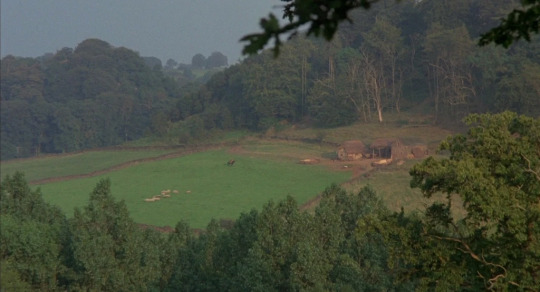
These elements, cinematography, lighting, costuming, special effects, etc., are the elements that can catch the attention of an audience, taking a ‘good’ film, and turning it into a ‘great’ film, thanks to the powers of movie magic.
See, movies are a very visual medium. You can have a good story and characters in a book, but you have to imagine what it looks like as it moves along. In a film, you have to watch what someone else made up. This can be either an advantage or a disadvantage, and the difference is made entirely thanks to production design. These ‘facets of film’, the trimmings that make a movie a movie, are vital to visual storytelling, enabling casual movie-goers to interpret what the framing of some scenes is trying to tell them.
Most audience members subconsciously internalize things like thematic costume changes, or a musical cue, without putting thought into figuring out what exactly was getting that point across. The point is, these ‘facets of film’ are not only for filmmakers or movie critics to think about and fawn over: This storytelling shorthand is an important tool that gives the audience all of the information they need to have, without spelling it all out in dialogue. Westley as the Dread Pirate Roberts wears all black as visual shorthand that he is dangerous, Humperdinck wears fine clothes to establish status and style, even Buttercup, whose clothing is plain when she is with Westley and uncomfortably bedecked when she is with Humperdinck, is dressed in a way that conveys something to the audience.
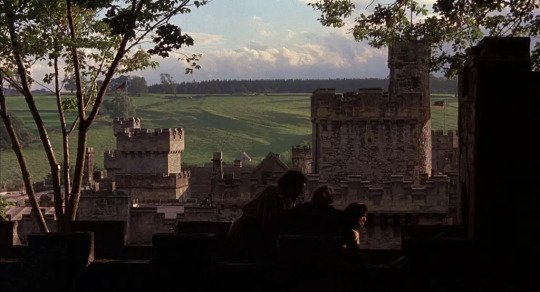
In other words, it’s very useful.
A good director knows to use these aspects of ‘storytelling shorthand’ well, as opposed to competently. Too often, directors can decide to focus the production crew, and the movie itself, in the wrong place, attempting to garner praise for production design rather than substance.
There’s nothing wrong with looking good and being a well-done movie from a technical standpoint, but the balance is necessary. A good director knows that visual storytelling accentuates its story, rather than overshadows it, intended to get the plot across in the most effective way possible, focusing on what is important: the story and characters.
Much like The Princess Bride does.
The Princess Bride isn’t exactly a blockbuster-style film. There isn’t a huge budget spent on special effects or huge setpieces, but what is in there is done so with a remarkable touch. Every inch of this film is designed to look like it takes place in a fairy-tale story, not exactly ‘real locations’, but looking like pictures you’d find in a story book. That extends to the camerawork.
Camerawork is a pretty big deal in film for obvious reasons.

The way a director uses a camera can tell the audience a lot, using some shots to emphasize different emotions, or even to get across different feelings to the audience. Filmmakers use editing of these shots together to tell the story, to move the audience’s line of vision so that it is always centered on the action while also helping to set the mood or leave a visual impression on the audience.
So, does The Princess Bride manage that?
Most of the camerawork in The Princess Bride is fairly standard stuff, wide-shots for action, close-ups for dialogue or emotion, establishing shots for a new location, etc. However, there are a handful of tricks that are notable: natural lighting used in the shots to make them feel open, spacious, and real, contrasting with artificial levels of darkness in the Fire Swamp, or the upwards-facing shot of Fezzik’s impersonation of the Dread Pirate Roberts, seeming to increase his size and formidability. Other shots, like the coming-into-focus of Westley rising to point his sword at Humperdinck, are equally effective, in uses of ‘subjective camera’. There are other, more traditional examples: shots of Buttercup’s abduction from above to make her seem even smaller, and establishing ‘relationship’ shots of people on the same level in the same frame, such as the sunset-lit kiss sequences bookending the film. Even the editing, while being mostly standard, is given a few moments to shine, such as when the Grandfather is trying to find his place in the story after interrupting to make sure the Grandson isn’t frightened by the Shrieking Eels.

Still, overall, it’s a fairly simple film in terms of visual style. The cinematography is aimed at one goal: creating a charming, warm, comforting atmosphere that translates well and correctly conveys the mood of the audience.
This is even more so aided by the film’s score.
It’s fairly obvious that a movie’s soundtrack is integral to its success: a good movie can be elevated to iconic levels thanks to a good score (i.e. Jaws, Psycho, Star Wars, etc.). In other cases, music can be passable, serviceable, without being bad or fantastic.

In the case of The Princess Bride, the score is….interesting, to say the least. Instead of a traditional ‘fantasy’ score, the soundtrack was composed by Mark Knopfler, the front guitarist for the band Dire Straits (Money for Nothing, Walk of Life), using synthesizers and acoustic guitars to get the sound of the film. The score, especially both the instrumental and vocal covers of ‘Storybook Love’ (sung by Willy DeVille) is memorable, overall, if nothing to write home about. The soundtrack does what it is intended to do: set the scene, notably in the scene ‘The Chatty Duelists’, where Inigo and Westley fight to the stings of the music. The music overall accentuates the grand, sweeping visuals as well as the tense, exciting sequences, keeping the audience in the story very well.
Speaking of grand, sweeping visuals:
The sets of The Princess Bride overall aren’t really ‘sets’ at all. The ‘Cliffs of Insanity’ were in actuality the Cliffs of Moher in Ireland, and even Humperdinck’s castle was actually a real medieval manor house. From Miracle Max’s shack to the Fire Swamp, to Rugen’s torture chamber, the rest of the settings of The Princess Bride do their job very well, creating a fantastical atmosphere that serves the story admirably. These aren’t the vivid, magical sets of The Wizard of Oz, designed to create an atmosphere of dreamlike fantasy, rather, the settings of The Princess Bride are more intended to create a feeling of Magical Realism, that it is a storybook, but that the locations look and feel familiar and realistic. This is helped somewhat by the fact that the film itself doesn’t rely on special effects much at all: aside from the Shrieking Eels and the (rather unrealistic looking) ROUSes (saved by the storybook feel of the entire film), there aren’t any real fantasy-specific special effects that other films might utilize.

There’s more to an immersive movie experience than sets, costumes and music, though. In the end, no matter how impressive, the special effects, sets and costumes don’t really mean anything if the characters aren’t believable. The movie really rests on the shoulders of the performers: it’s on the actors to try to sell not only their surroundings and story, but the characters themselves, everything from the personality to the emotions.
In the case of The Princess Bride?
Cary Elwes’s performance as Westley is lighthearted, emotional, and extremely sincere. He’s charismatic, charming, and makes you believe that he’s exactly as skilled as the story needs him to be. He also manages to convince an entire audience of the genuine love he has for Buttercup, and is distinct as both his Westley persona and his ‘Dread Pirate Roberts’ persona. In other words, he’s perfect.

Cary Elwes balances the ‘indestructibility’ that most protagonists seem to possess, seemingly in control of dire situations, as well as the vulnerability necessary for an audience’s sympathy and concern for his well-being, for his goal. In other words, he manages to pull off a character that seems designed for an earlier time, updating it with a sense of humor and charm that perfectly suits the rest of the film.
Robin Wright is similarly well-suited for Buttercup, as she’s written. I’ve discussed elsewhere the potential problems presented by Buttercup’s rather uninteresting personality and role in the story, but Buttercup’s Defrosting Ice Queen tendencies are very well conveyed, especially early on. As I mentioned in other articles, her chemistry with Elwes makes the romance element of the film convincing in the few scenes they have together. She does a good job with the material given to her, it’s just a shame that there wasn’t more for her to do.

On the other hand, Mandy Patinkin as Inigo Montoya, despite the unconvincing accent, is inspired, with Patinkin bringing both warm humor and ice-cold vengeance and formidability to the role. Both he and Elwes brought great physicality to their sword-fight sequences, training hard in order to do as much of their own fighting as possible, and it shows in the performances in the final product. Inigo’s inner conflict is showcased well, with Patinkin providing both the comedic highlights as well as the intense emotional ones, especially his final duel with Rugen. It is Inigo’s lines which tend to be the most memorable, owing a lot to Patinkin’s iconic delivery.

All three of the main trio play their parts perfectly, but they are only the chief standouts in an entire film full of them.
André René Roussimoff (better known as André the Giant) despite not being an actor in the same vein as the rest of the cast, is iconic as Fezzik. The instant likeability present in the performance carries strongly throughout the film, with his own fair share of memorable dialogue (which, granted, nearly every member in the cast has). His physicality isn’t really what makes him such a distinct part of the cast, rather, it’s the character’s heart and humor that makes this performance such an integral part to the film at large.

Similarly (though in the opposite direction), Wallace Shawn is a wonderful choice for Vizzini, his distinct voice and mannerisms giving the character plenty of funny dialogue without entirely removing the threat he poses. Despite not having a lot of screen time, Shawn manages to make the role iconic instantly, with inflections that make the word ‘inconceivable’ memorable to this day.

Chris Sarandon is perfectly cast as Prince Humperdinck, playing arrogance and control that all come crashing down in the final scene. Humperdinck is all bark and no bite, appearing confident and competent until he is met by someone who might pose a challenge. He’s conniving, cold, and disinterested in anything other than his war, making it especially rewarding when he is defeated.

Similarly, Christopher Guest plays Count Rugen with a sophisticated coolness, never really invested in what’s going on or terribly worried about it until that ‘little Spanish brat’ comes for revenge, very well equipped to deliver it. He plays the final duel scene notably with an increased losing of composure, cluing the audience in to his inevitable demise for the sake of vengeance.

The other characters perfectly hit their mark as well: Billy Crystal and Carol Kane are a comedic team to be reckoned with as Miracle Max and Valerie, with other special standouts including Peter Cook as the Impressive Clergymen (a scene stealer with only one appearance), and Peter Falk and Fred Savage as the Grandfather and the Grandson, respectively.
Every character in The Princess Bride comes across exactly as they should: as characters in a fairytale, fondly looked back on from a place of adulthood. Each performance is perfectly suited to each character and the type of movie that they are in, with every performance hitting a mix of sincerity and drollness. These performances aren’t necessarily subtle, but they aren’t supposed to be. They are heroes and villains, giants and master swordsmen and princesses, acting out a fairy-tale that knows exactly what it is, with tonal consistency that never seeks to outdo the material the actors are given. These performances are the final piece to cementing this film as a true classic, bringing entertainment to people decades after it’s first release.

In short, the filmmakers of The Princess Bride knew what they were doing. Everything from the performances to the camerawork gets across every emotion and aspect of the story instantly, with the sets and costumes working to explain simply what’s going on as quickly as possible. It’s a storybook set to film, both comforting and exciting, and the ending feels right, no matter how many times we revisit it.
The Princess Bride has long been considered a cult classic, a hidden gem that was looked over by a public who never really knew it was there in the first place. Even if it never reaches the high peaks of fame as other fantasy classics, it may not be a stretch to hail it as one of the greatest fantasy films (or films in general) ever made, through simple (but not simplistic) substance, if not bombastic style.

Of course, no movie comes around accidently. There had to be some work done behind the scenes for this film to have come about.
Join me next time as we discuss the Facets of Filmmaking: the Behind the Scenes of The Princess Bride.
Thank you guys so much for reading! If you have something you’d like to add or say, don’t forget that the ask box is always open! I hope to see you all in the next article.
#The Princess Bride#The Princess Bride 1987#1987#80s#Adventure#Comedy#Fantasy#Family#Romance#PG#Cary Elwes#Robin Wright#Mandy Patinkin#Chris Sarandon#Christopher Guest#Wallace Shawn#André the Giant#Peter Falk#Fred Savage#Rob Reiner#Film#Movies
11 notes
·
View notes
Text
How Black Lagoon Begins Attacking Gender Norms
by Bunnypwn Gold
Rei Hiroe’s Black Lagoon is one of the most intelligent, fun, and kinetic action-crime dramas around. The entire series looks and feels like an action movie; even the way it’s structured feels more akin to a series of movies, with different self-contained arcs building off of the previous installments. While many action movies include philosophical elements and dialogue in an attempt to make the festival of blood and explosions seem more intelligent without exploring the issues, Black Lagoon actively builds its themes and the substance of its plot and character arcs around its stellar action-hero philosophy quotes. One of its strongest points is how integral all the characters’ social identities are to the way the story is told. Chief among these is the way gender is explored and examined. Looking through the first five stories of the series, a powerful message about breaking out of the toxic gender binary is developed, creating an argument that drives the rest of the series. This argument is never made explicitly, but instead through the pattern of behaviors exhibited by Japanese salaryman Rock, as the feminine, and hotshot gunslinger Revy, as the masculine.
For anyone who has not read the series, a little catch-up is in order. At the beginning, Okajima Rokuro, a generic Japanese salaryman, is kidnapped by Revy, the gunhand of Lagoon Traders, a company of underworld couriers. Rokuro was in possession of a disc the Lagoon Traders were hired to steal, and Revy wanted to sweeten the pay with some ransom. During a shootout with mercenaries hired by Rokuro’s company and a chase to certain death, Rokuro goes from wanting to return to his ordinary life, to finding out his bosses are planning to let him die, and finally to diving into the underworld as a crewman aboard the Black Lagoon, taking up the nickname Rock. He then spends the first few stories of the series being taught how to perform basic duties and tasks aboard the torpedo boat by Revy until they have a falling out and make up after a dramatic argument. It is this series of events that sets up the larger dialogue on gender in the rest of the series.
In an interview published for Sunday GX magazine and printed in volume 8, series author Rei Hiroe and Gen Urobuchi, author of the Black Lagoon novelization, discuss their views on gender in light of the series’ myriad badass women. In it, Urobuchi is quoted as saying,
“I naturally have this idea that women are strong or tough. Like men are just male bees—creatures that should die after they ejaculate…In that sense men are weak. Whereas the battle begins for women once they get pregnant…Women have to keep fighting. I don’t see that kind of strength as cute. I can’t dote on it.”
Later on, when discussing the final scene of The Wild Bunch, in which the heroic cowboys go off to their deaths trying to save their friends, Hiroe and Urobuchi have the following exchange:
Hiroe: “They’re already dead at that point. That’s what’s so cool. They have no intention of getting out alive.”
Urobuchi: “That’s really the only moment men can compete with women, I think. There’d have to be a third world war for men to shine. Like a Mad Max type of world. Maybe only when there’s a real danger of extinction will men have a role. Right now this society could exist only with women.”
This lays out the core of the series’ argument about gender: women are strong because they fight to live and make life, whereas men place all their value on their own deaths and the deaths of others, and the current gender binary denies women their strength and forces them into submission with the violence of death-based masculinity. This is somewhat familiar, since associations between the genders and life and death in this vein are common across cultures. What is particularly instructive for how the series is constructed is how the machismo, male-dominant view of gender is embedded in action movies, particularly cowboy movies. For anyone who has read Black Lagoon, it’s clear how powerful an influence cowboy and other action movies have on the series.
Rock spent his life as a low-level employee in a large Japanese company. Like most companies around the world, large Japanese corporations like the one Rock worked for are male-dominated and are typified by traditional ideals of masculinity, with the CEO and board of directors, among others, working in the role of powerful, great men, and everyone under them working their way closer to that great ideal of manhood. Rock, being so low in the company, is far from manhood, in that sense; he describes his job as mostly consisting of bowing to superiors, and his general conciliatory, subservient attitude throughout the early part of the series can easily be read as traditionally feminine. From that perspective, his time at that company can be read as emasculating (for more on the idea of emasculating corporate culture and men trying to take back their manhood with violence, see Fight Club). Rock even reveals that he would blow off steam at a batting cage, which is a notably phallic activity, with bats and balls, and, being a sport-based hobby, is more traditionally masculine by nature; in a sense, after constantly kissing ass and being forced to get drunk to keep his bosses happy, he recharged his masculinity by knocking his stress into the far end of the cage.
Revy, on the other hand, fits perfectly into macho-violent cowboy movie masculinity during the first set of stories. If she had been replaced by a man, then superficially the story could have been told the same way, with the only difference being that Rock would likely have been a little less shocked to see Two Hand smile while he killed all those mercenaries. She’s short-tempered, mean, constantly looks out for herself before anyone else, and is just so indignant that she has to take orders from anyone. She’s greedy and aggressive and takes great joy in both risking her life and taking the lives of others. Throughout the first few stories, Revy often complains that every little thing Rock does wrong costs her money, and she’s not particularly generous with her own. Though she continues this throughout the rest of the series, and so it isn’t specific to this period, the fact that Revy is most often seen in her downtime looking at porno magazines promising the largest-breasted women around drives home the kind of macho, hypermasculine role she fills. We later learn that she grew up on the streets of NYC, having to run from street criminals and violent police officers. She would take up the gun at age 11 and begin emulating the only kind of power she knew up to that point: the violent men who terrorized her. Her worldview is defined by this dog-eat-dog attitude, with people being nothing more than dead bodies waiting to happen and profit from. She’s so scared of showing vulnerability and anything that could be seen as feminine because the last time she was vulnerable and feminine, she was nearly killed in the gutter by dirty cops.
The pilot chapter of the series sets out to demonstrate the gendered positions of Rock and Revy. Revy starts off the chapter by messing up her boss Dutch’s plan by kidnapping Rock for extra cash. She is then indignant when Dutch reprimands her for this, because she was trying to take initiative and be independent, masculine qualities often praised at companies such as the one Rock worked for. Rock spends all his time whining, or as Revy calls it, “bitching,” about what’s going on, being very demanding, and wanting everyone to take care of everything for him, all of which puts him in a stereotypically feminine role, and a negative one at that. At the bar, Revy belittles Rock’s manhood for drinking beer, saying rum “is what a real man drinks,” and ends up in a drinking contest, because Rock has to prove he’s a man despite his feminine role and Revy, as a “real man,” can’t back down. Revy then demonstrates her penchant for and love of violence as she kills a bunch of the EO mercenaries hired by Rock’s company to kill them and retrieve the disc, just living her best life. The turn for Rock in this chapter is when he talks to his boss and finds out he plans to let Rock die; the company leaders will reward his death with their presence at his funeral, showing the masculine value of death and the power of the executives’ masculinity that their presence is meant to be that great a reward. As the mercenaries chase the Lagoon into the straits, Revy demonstrates her masculine lack of regard for her own life by nonchalantly resigning herself to death. Rock, on the other hand, embraces the opportunity to take up the masculinity his company denied him by devising an insane plan to win the day. After coming out on top and choosing to join the Lagoon, however, that masculinity starts to change for Rock. By choosing to join the Lagoon, Rock was choosing that as his way of life, not simply the place he was willing to die. For Revy’s part, it’s easy to read the way she relishes her part in Rock’s plan as a cowboy choosing to die how she lived, but it can also be read as her accepting a way to fight to stay alive in the way she sees best, which is itself an important turn for Revy. These points are developed further in the rest of the opening of the series.
Throughout the next four stories, Rock remains at the low end of the totem pole, still receiving his training and unsure of how he will actually make his living on the Lagoon, placing him in a similarly feminine position as he was in as the errand boy in a large corporation. Revy emphasizes this with her masculine sense of inherent authority, constantly bossing Rock around and belittling him for failing to learn sailing knots faster or not checking his scuba gear thoroughly. Revy also buys Rock a Hawaiian shirt, which is never seen because Rock refuses to wear it. While buying clothes for a man may be seen as feminine, it more resembles Revy trying to institute a work uniform, since she got it to replace the semi-formal work clothes Rock still wears; it should be noted that Benny, the Lagoon’s engineer and another man who takes a passive position in the crew, wears a Hawaiian shirt. Revy’s masculine position is further solidified in Ring-Ding Ship Chase, the second story, when she single-handedly took out several motorboats filled with heavily-armed men and mounted with machine guns. Rasta-Blasta, the third story, pushes in another direction, with Revy taking a masculine approach to watching over Garcia, the young boy they’re transporting for sale, by threatening to beat and kill him when he won’t comply with orders. Revy’s role can be read as either paternal disciplinarian or like a cowboy angry because kids, which she never wanted, cramp her style. Rock takes on the maternal role in how he deals with Garcia in that story, being more gentle and nurturing. Later on, Rock tries to stop Revy and ass-kicking terrorist-turned-maid Roberta from fighting to the death partly in an attempt to protect them as women, because he still thinks like how things work in Japan. But of course, Revy has to fight Roberta, because, as a “real man,” she can’t stop before things are settled.
Die Rückkehr des Alders, the fourth story, represents the major turning point in this opening arc. During their mission to salvage a Nazi painting from a sunken German sub, Revy leaves Rock behind for a moment to take medals and things from the dead soldiers so she can make a little extra money on the side. Rock takes a stand, saying she should leave them behind. While taking a stand can be read as masculine, Rock does so in defense of what the medals meant to the soldiers, and how those sentiments are more valuable than whatever money can be made from them, essentially taking a feminine position in support of life and love. The fact that Rock backs down by the end is what really does in any hope of this being a masculine moment for Rock. Revy, on the other hand, lays out the bare bones of her cowboy “we’re dead men walking” mentality, pushing herself further into the macho corner. Here is where she reveals what her childhood was like and argues that the bones in the sub and the medals were essentially the same: just things. There’s no value in things like sentiment, which people build lives around. She’s literally placing monetary value on the deaths of Nazi soldiers, the starkest version of her masculinity. She continues when raiding the neo-Nazi ship by killing everyone she sees, including the hired staff who were unaffiliated with the neo-Nazis. When she kills them, she doesn’t have her usual smile, a sign of how her desire to remain in this powerful role is stressing her, how it’s not really bringing her a happy life.
The big conclusion happens in the follow-up story Calm Down Two Men, which sees Revy and Rock going on a simple errand run and then getting lunch. During the errand run, both demonstrate their typical patterns of behavior. Rock is more submissive, just trying to get along, and Revy is aggressive and angry, using violence as her way of handling business. Their roles here play out fine enough with the first two errands, but Revy nearly gets them into a shootout at the Rip-Off Church before Rock saves the day with some diplomacy. Revy is put on edge as Sister Yolanda tells Revy to learn from Rock, which would disrupt her status and position in multiple ways. At lunch, they get into an argument which ultimately dispels the tension left between them after their time in the sub. It is instigated by Rock, who is taking a stand for his principles, a stand that demonstrates his new masculinity. Revy tries to take control back quickly by threatening to shoot Rock dead, since she refuses to be put onto the defensive, which she would interpret as a weak, vulnerable feminine position. Rock redirects the gun and later takes a punch without flinching to show that he can’t be stopped with violence. Rock speaks here about how he got by at work before, and how Revy inspired him by showing how much more he could have in life. This scares Revy, putting her on the defensive, to hear someone demonstrate how hollow and insignificant the power she was wielding truly was. Eventually, Revy sees that Rock is actually offering her something more powerful in exchange and takes him up on it. To sum up Rock’s offer, “Well, if there aren’t any Robin Hoods…then BE a Robin Hood,” meaning take a stand for the principles you want to uphold in life. Before the chapter is out, Revy asks Rock if he’s with her or against her, just like in the sub, in an attempt to place her new path near her familiar ground. Rock doesn’t allow her that simplicity.
In this way, the two switch places in their gender roles by the conclusion of this opening arc, but do so in a way that breaks them free from the stereotypical gender binary. Just as Urobuchi put it, Rock has fully formed his new, life-affirming masculinity by the end of the argument, while Revy is only just starting to chart the course of her new, powerful femininity; to complete the parallel to sex described by Urobuchi, Revy and Rock smoke after their fight and “kiss” their cigarettes to light Revy’s. The argument fully demonstrates how the old gender binary our heroes left behind was damaging to each of them, with Rock left emasculated and, more importantly, unable to live life his own way because of how he always came up short of expectations, and Revy being a tightly-wound ball of self-destructive anger and violence doomed to leave this world without having really gotten anything out of it. Overall, it’s a clever, subtle, and effective way to demonstrate why traditional gender roles are harmful and degrading to all involved. While, as a nonbinary person, I have to point out it still is based on a binary view of gender, it’s still an interesting way to demonstrate how breaking free from the traditional gender binary is empowering and can redefine the course of a person’s life for the better.
153 notes
·
View notes
Text
Fanny Price and Emotional Abuse
colubrina replied to your post “Emotional Neglect in Austen”
I would actually love to read your analysis of Fanny Price if you ever had time and inclination to write it out.
Oh my goodness, where do I start?
Fanny Price is abused and neglected from start to finish of that novel. She suffers direct emotional/verbal abuse from Mrs. Norris, bullying from Maria and Julia, excessive criticism from those three AND Sir Thomas, and emotional neglect from Lady Bertram and Tom. She also suffers PHYSICAL abuse and neglect, mostly from Mrs. Norris, who does not allow her to have any heat in her room in the winter and forces her to work beyond her strength in the summer even though Mrs. Norris KNOWS she’s chronically ill (and it’s no wonder, considering the amount of emotional strain Fanny’s under, that she should be chronically ill!).
The only person in that house who even notices that she’s utterly miserable from the trauma of being torn from her family is Edmund: he’s the only one who treats her like a person and is kind to her. It’s no WONDER she falls in love with him: he’s the only person in the entire family who doesn’t treat her like SHIT. But while Edmund recognizes Mrs. Norris’ behavior toward Fanny to be beyond the pale, he generally does not seem to notice that his more immediate family also treats her horribly. Lady Bertram treats Fanny as a servant, putting her own (Lady Bertram’s) needs and wants before Fanny’s (”You don’t want to go to the party, do you? You want to stay home with me because I get bored if you don’t!”). Sir Thomas is generally so critical and cold that when he greets Fanny kindly on his return from Antigua she is “nearly overcome” by his kindness. Even Edmund himself begins to both emotionally and physically neglect Fanny the moment he gets interested in Mary--leaving Fanny for ages on the bench alone, keeping her waiting too long for her horse when she needs to exercise, etc. Fanny only gets noticed and included as a member of the family when Maria and Julia are both gone and the family is apparently bored without them--the same reason Henry decides to flirt with her.
The result is that Fanny has almost no self-esteem. She has completely internalized Mrs. Norris’s lesson that “Wherever you are, you must be the lowest and last.” At one point she parrots the lessons she’s been taught by the treatment of the entire family:
“I can never be important to any one.”
“What is to prevent you?”
“Everything. My situation, my foolishness and awkwardness.”
“As to your foolishness and awkwardness, my dear Fanny, believe me, you never have a shadow of either.”
She believes she’s foolish and awkward because the family harped on her lack of education and “refinement” when she first came to them, and they have drilled into her, not only that she is not important to them, but that she can never BE important to ANYONE. Classic result of emotional neglect. And Fanny NEVER actually gets over it, throughout the entire book.
She’s nearly silent through much of the book too, mostly because she’s too terrorized to talk. As someone who was similarly brainwashed by emotionally abusive parents, I can tell you that taking any attention under some circumstances feels excruciating and guilt-inducing, because you’ve been conditioned so hard to believe that “being the center of attention” is somehow morally WRONG. Fanny suffers from precisely that false belief (note her distress when she is required, by the social rules of the day, to start the dancing at her own ball--Sir Thomas basically has to SCOLD her into it!).
That said, it’s amazing to note the one way in which she DOES have self-esteem: she believes in her own moral judgment. This is the only basis on which she is able to think and act independently of others. When Edmund treats her badly, she gets seriously annoyed. When she notices Henry’s bad behavior toward Maria, she is indignant. She secretly judges Mary Crawford the whole way through the book. I would attribute this trust in her moral judgment to be the result of the kind of long walks and talks she has with Edmund in the text and has had her entire life: he has molded her to think of things with the same moral judgment he uses and to think herself capable of being superior to others in that moral judgment. Of course, since she has absorbed the moral tone of Edmund, learned from Sir Thomas, she is pretty judgy sometimes, since Sir Thomas clearly feels himself and his moral code to be superior rather than conservative. She certainly feels superior to her birth family (with some reason, honestly lol), because in this one thing she has been taught that the family she grew up in was superior to others. She has imbibed this superiority and acts it out when at Plymouth.
Let me give you an example of Sir Thomas’s conservative moral code. You might think, from reading Mansfield Park, that Jane Austen disapproved of private theatricals, and that they were generally considered too naughty by the Better Sort of Person. It turns out that this isn’t true at all. Not only were private theatricals popular, but Jane Austen enjoyed performing in them and even WROTE some plays for that purpose! One of them involves a gentleman sitting on a lady’s lap!! It turns out that the strait-laced tone of the novel is not so much a reflection of the author’s standards of conduct, but of Sir Thomas’s, imbibed by Edmund and then Fanny. Edmund, Fanny, and Sir Thomas’s dislike of private theatricals would have been a bit PRUDISH at the time, not the obvious standard of Good Breeding.
Another thing the novel has imbibed from Sir Thomas is its insularity. The modern criticism of Mansfield Park talks a lot about the family’s isolation. Now, I don’t hold with the criticism that makes a big deal out of Fanny marrying her cousin and implying that that’s incestuous, because in the 19th century, cousin marriage was not only acceptable but a norm. Marrying your cousin was often considered desirable because it strengthened family ties and kept money in the family. BUT, I completely agree with the observation that the Mansfield Park family seems to shun the outside world.
One thing that I don’t know if the criticism has commented on is that dysfunctional families often function like cults. Offspring of dysfunctional families tend either to rebel and “run away” (Maria elopes, Julia elopes, Tom rebels) or to fail to establish autonomy (Edmund takes a living in Sir Thomas’s gift and later the house right down the road; Fanny never gets out of the family at all because she marries Edmund). Dysfunctional families also teach their members not to trust those outside the family circle. They don’t tend to socially interact much with others. I can say from personal experience that my parents have VERY few friends that they see outside of work or church, and only one couple that they invite to the house regularly. As a child, I rarely got to have birthday parties with my friends: my parents would instead invite my extended family. I was taught not to establish strong bonds outside the family, to trust the family only to be generous or to help and support me. I find it difficult to establish strong ties of friendship outside the family or to trust those friends to support me the way my family might.
The Bertrams are the same way. Maria and Julia go to local balls, but that happens offscreen, and we never meet any of their acquaintances except Mr. and Mrs. Rushworth (who become family). The family disapproves strongly of Tom’s having such an active social life away from home, and disapproves when he brings home a friend (Mr. Yates) to stay. Even when Sir Thomas holds a ball for Fanny in the house itself, we never actually meet any of the guests except the ones we already know! And the “last straw” that causes Edmund to agree to join the theatricals is when they start asking people “outside their circle” of Mansfield and the parsonage to participate. He also deplores that they might invite in an audience of these personae non gratae. Frankly, it’s amazing that the Bertrams were willing to open their family circle enough to let in, not only the Grants, but the Crawfords.
I’ve gone on for quite awhile, but I’ll close like this. When I first read Mansfield Park, I hated it and I hated Fanny, because she had no backbone and cried all the time. Then I watched the 2007 adaptation with Billie Piper, and realized that although Fanny was so shy and retiring and weepy, she had an iron backbone in that nobody could make her do what she thought was wrong. Mansfield became one of my favorite Austen novels.
At the moment, I don’t feel like I can reread MP. I’m dealing so much with my own history of emotional abuse and neglect that MP strikes just waaaay too close to home (also the reason I can’t rewatch Tangled right now). I’m not sure how much I like MP anymore, frankly. Austen did a fantastic job of accurately portraying a victim of emotional abuse. And she gave Fanny what she wanted at the end, which was Edmund. But I can’t help wondering if Austen herself wished she could have ended the novel differently. She comes right out and says, authoritatively, that if Edmund had married Mary, and Crawford hadn’t run off with Maria, that Fanny would have married Crawford and been happy. She could have escaped from her abusive family, with someone who really sees their abuse: “And they will now see their cousin treated as she ought to be, and I wish they may be heartily ashamed of their own abominable neglect and unkindness.” If Crawford and Maria hadn’t run off together, the ending of Mansfield Park might have been entirely different--and it MIGHT have been better.
28 notes
·
View notes